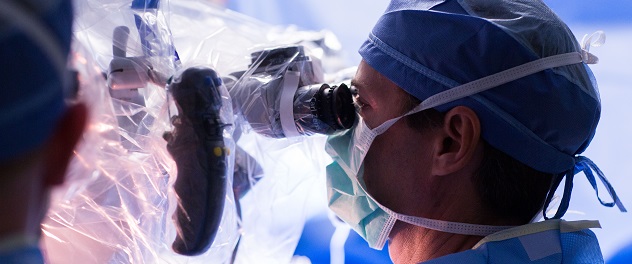
Otology, neurotology and lateral skull base surgery research drives improvements in interdisciplinary treatment of tumors that affect hearing.
Otology, Neurotology and Skull Base Surgery
Otology, neurotology and lateral skull base surgery research into hearing disorders in the Mayo Clinic Department of Otolaryngology — Head and Neck Surgery is centered on three concepts:
- Hearing preservation
- Hearing restoration
- Auditory rehabilitation
Incremental advances in the understanding of the molecular and physiologic basis for hearing loss — gained through basic science research and clinical studies — have led to new and improved therapeutic options for patients. These advances are made possible through close collaboration with expert colleagues in areas including:
- Audiology
- Behavioral neurotology
- Clinical genetics
- Internal medicine
- Neurology
- Neurophysiology
- Radiology
Primary focus areas include vestibular schwannoma, cochlear implantation and molecular genetics pertaining to sensorineural hearing loss.
Vestibular schwannoma
Researchers in the Mayo Clinic Department of Otolaryngology — Head and Neck Surgery's Division of Otology, Neurotology and Skull Base Surgery are finding the best ways to treat vestibular schwannomas, which often negatively affect hearing, balance, facial nerve function and quality of life. Clinical studies are underway to discern which clinical presentations may be best suited to the current treatment options of observation, stereotactic radiotherapy or surgery.
Researchers are also developing systemic medical therapies for people with neurofibromatosis 2-associated vestibular schwannomas in whom standard therapies have failed. Identifying targeted therapies that stop the growth of vestibular schwannoma cells in the laboratory may help decide which therapies to advance into the clinical setting.
Related publications:
- Carlson ML, Link MJ, Wanna GB, Driscoll CL. Management of sporadic vestibular schwannoma. The Otolaryngologic Clinics of North America. 2015; doi:10.1016/j.otc.2015.02.003.
- Carlson ML, Marston AP, Glasgow AE, Habermann EB, Sweeney AD, Link MJ, Wanna GB. Racial differences in vestibular schwannoma. The Laryngoscope. 2016; doi:10.1002/lary.25892.
- Feng Y, Patel NS, Gompel JJV, Carlson ML. Translabyrinthine approach for resection of vestibular schwannoma. Journal of Neurological Surgery Part B: Skull Base. 2019; doi:10.1055/s-0039-1677856.
- Lees KA, Tombers NM, Link MJ, Driscoll CL, Neff BA, Van Gompel JJ, Lane JI, Lohse CM, Carlson ML. Natural history of sporadic vestibular schwannoma: A volumetric study of tumor growth. Otolaryngology — Head and Neck Surgery. 2018; doi:10.1177/0194599818770413.
- Macielak RJ, Patel NS, Lees KA, Lohse CM, Marinelli JP, Link MJ, Carlson ML. Delayed tumor growth in vestibular schwannoma: An argument for lifelong surveillance. Otology & Neurotology. 2019; doi:10.1097/MAO.0000000000002337.
- Marinelli JP, Grossardt BR, Lohse CM, Carlson ML. Is improved detection of vestibular schwannoma leading to overtreatment of the disease? Otology & Neurotology. 2019; doi:10.1097/MAO.0000000000002281.
- Nakatomi H, Jacob JT, Carlson ML, Tanaka S, Tanaka M, Saito N, Lohse CM, Driscoll CLW, Link MJ. Long-term risk of recurrence and regrowth after gross-total and subtotal resection of sporadic vestibular schwannoma. Journal of Neurosurgery. 2017; doi:10.3171/2016.11.JNS16498.
- Van Gompel JJ, Agazzi S, Carlson ML, Adewumi DA, Hadjipanayis CG, Uhm JH, Olson JJ. Congress of Neurological Surgeons systematic review and evidence-based guidelines on emerging therapies for the treatment of patients with vestibular schwannomas. Neurosurgery. 2018; doi:10.1093/neuros/nyx516.
- Vivas EX, Carlson ML, Neff BA, Shepard NT, McCracken DJ, Sweeney AD, Olson JJ. Congress of Neurological Surgeons systematic review and evidence-based guidelines on intraoperative cranial nerve monitoring in vestibular schwannoma surgery. Neurosurgery. 2018; doi:10.1093/neuros/nyx513.
- Zanoletti E, et al. Surgery of the lateral skull base: A 50-year endeavour. ACTA Otorhinolaryngologica Italica. 2019; doi:10.14639/0392-100X-suppl.1-39-2019.
Hearing rehabilitation
If clinicians are unable to preserve or restore patients' hearing, then they must consider hearing rehabilitation options, including:
- Hearing aids
- Cochlear implants
- Brainstem implants
- Hybrid devices — a combination of a cochlear implant and conventional hearing aid
With regard to cochlear implantation, researchers have directed significant effort to hearing preservation. These efforts include using novel surgical techniques and methods to monitor residual hearing during cochlear implantation, evaluating implantation in very young patients to improve overall performance, and developing methods to streamline cochlear implant care.
Mayo's cochlear implant team is well established and — under U.S. Food and Drug Administration (FDA) oversight — is investigating the most advanced devices available. This research is conducted in close collaboration with the Division of Audiology.
Related publications:
- Carlson ML, Patel NS, Tombers NM, DeJong MD, Breneman AI, Neff BA, Driscoll CLW. Hearing preservation in pediatric cochlear implantation. Otology & Neurotology. 2017; doi:10.1097/MAO.0000000000001444.
- Gifford RH, Driscoll CL, Davis TJ, Fiebig P, Micco A, Dorman MF. A within-subject comparison of bimodal hearing, bilateral cochlear implantation, and bilateral cochlear implantation with bilateral hearing preservation: high-performing patients. Otology & Neurotology. 2015; doi:10.1097/MAO.0000000000000804.
- Van Abel KM, Dunn CC, Sladen DP, Oleson JJ, Beatty CW, Neff BA, Hansen M, Gantz BJ, Driscoll CL. Hearing preservation among patients undergoing cochlear implantation. Otology & Neurotology. 2015; doi:10.1097/MAO.0000000000000703.